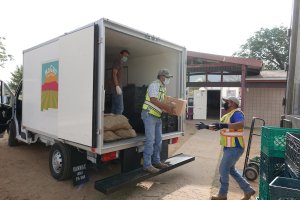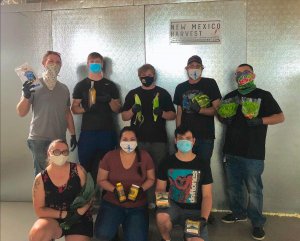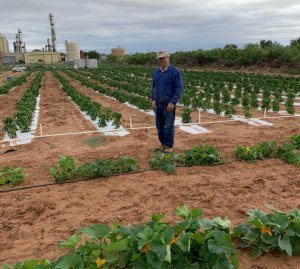This article was originally published in the Green Fire Times September/October 2021 issue Growing a Regional Food System.
Authored by ESHIP Rio Grande council member, David Sundberg, with interview support by ESHIP Rio Grande Local Director, Erin Ortigoza, this piece engages in deep storytelling with a few people who are striving to create a healthier and more equitable New Mexico through food hubs.
"Communication is essential for transforming an idea into action. We all grow stronger when we’re well-nourished."
David Sundberg, ESHIP Rio Grande Council Member
Think about this for a moment: How and where do you access your food?
Grocery stores, online, restaurants, convenience stores, workplace cafeteria, CSAs or farmers’ markets? Take the image of that place and the food you get there and walk out the back door. Where do they get their food? See how far back up the line you can follow your food. Can you trace it all the way to the field where it grew? If you can’t, you probably aren’t getting fresh, local food.
A handful of organizations and businesses in New Mexico—food hubs—are working to change that. A food hub is “a business or organization that actively manages the aggregation, distribution and/or marketing of food products—primarily from local and regional producers—to strengthen their ability to satisfy wholesale, retail and institutional demand.” Food hubs are critical for suppliers to be able to sell to different markets, like schools, hospitals and retailers; and for value-added producers, foodservice directors, and individual consumers to have more options and locations to buy local foods. Food hubs also make it possible for emergency food programs such as food banks to get fresh, nutritious food.
Food hubs get local food from the field to your plate. So, why aren’t there more of them? Making food hubs work takes a lot of planning, hard work, and tenacity. Common motivations that people who work for food hubs have include a passion to provide delicious, fresh food for their communities and a recognition that we need to support farmers and a local food economy.
Below are excerpts of conversations with a few people working for or developing food hubs in New Mexico. These people are committed to supporting farmers, ranchers, and local food producers with fair market pricing for their products. Thanks to their dedication, more New Mexicans have better access to healthy food produced by their neighbors — food that is hundreds, if not thousands of miles closer to home. We can enjoy this food, knowing that it nourishes our bodies and our lands and supports our economy.
You can find how to engage with your local food economy through farmers’ markets, Community Supported Agriculture (CSAs), and food hubs. Be deliberate about your food choices and how you access them. If you find yourself in a food desert — think about starting a hub in your community so you and your neighbors have better access to better food. Communication is essential for transforming an idea into action. We all grow stronger when we’re well-nourished.
MoGro—Sliding Scale CSA and Emergency Food Access
MoGro began in 2011 as a mobile grocery store—a semi-trailer custom outfitted with refrigeration and shelves that drove directly to tribal communities to provide better access to fresh produce and other products. In 2016, due to logistical challenges and to improve its intended impact, MoGro shifted to a CSA-inspired model. This allowed the project to work with a larger network of small-scale, local farmers to aggregate and distribute many more fruits and vegetables.

Currently, a powerhouse team of passionate, dedicated people pack bags with seasonal produce and staples that are delivered throughout northern N.M. and from Albuquerque to the Navajo Nation. In 2020, MoGro distributed 230,000 pounds of local produce and N.M.-made products, and also helped partner organizations such as Presbyterian Community Health and Three Sisters Kitchen access more locally sourced foods.
Customers order bags weekly online and may add products such as tamales, eggs, cheese and beans. The bags are delivered to central locations staffed by MoGro Champions who help people understand the benefits of healthy eating, learn new recipes and build a sense of community. The cost of a MoGro bag is $20 for those who can afford it and only $12 for essential workers who don’t get essential pay and those who can’t afford full price. It’s just $6 for people paying with EBT. This tiered structure subsidizes the cost for those who have the least access to fresh, healthy food.
Tina Whitegeese (Santa Clara/Pojoaque Pueblos), Community Outreach Coordinator
Q: How did you get involved with Mogro?
A: I was looking for something that would impact Native people in a positive way. MoGro was looking for a champion to help distribute food at the Indian Hospital. Fruits and vegetables are a part of healthy living but, unfortunately, a lot of Native people don’t get enough. We sometimes think about cheaper, faster, more convenient, and not everybody has access, time or resources to grow their own or get fresh food. Many health afflictions—diabetes, heart problems, obesity—get treated with medications, but I like the idea of food as medicine. I really connect with people talking about food, especially the more exotic ones, and how to use them.
Q: How do you see MoGro being most impactful in the communities you serve?
A: We provide access to people who may not otherwise get all this variety of fresh food. We work with small farmers and Native farmers who have more food than they’re able to use or trade with neighbors. They feel good about selling their products to people who really want and need it.
Q: How do you purchase food from Native farmers while respecting that food is not traditionally viewed as a commodity?
A: It doesn’t feel right to charge for something you have bountiful amounts of. I don’t think that’s a strictly Native concept; I think it’s a concept of community. A lot of Native farmers don’t see themselves as commercial farmers; the way their food gets shared is not a cash transaction. We approach them with the idea that if they have enough extra for us to be able to buy and share with others, having people eat their food is healthier and better than from some large commercial enterprise.
Q: What barriers does MoGro encounter in getting food from local farmers out to the community?
A: Government regulations around food safety. It can be hard for smaller farmers to get the certifications needed to sell their food. Access is also a challenge. People can’t get to fresh fruits and vegetables in their own communities, so it’s important that we have our distributions where they’re most needed. But we have limited points and times. Variety is a challenge as well. Some weeks and through the winter, all local farmers have is lettuce, so we have to source from outside to get the products our customers want. The higher cost of local foods is also difficult. We provide our fresh fruit and vegetable bags to SNAP recipients at a low cost, so it’s difficult to be sustainable when we’re spending more on products.
Q: Where does MoGro excel?
A: Consistency. We’re always in the same place week after week, so word gets out and people get to know us. Through social media postings, people know to stop by even if they haven’t ordered ahead. We reach out to people who are on food assistance and make sure they have access. Everyone at MoGro has a sincere intent to keep their community healthy with unprocessed fruits and vegetables.
Q: What helps you and MoGro be successful?
A: Funding. Refrigerated trucks, staffing and food all cost money, so it helps support all the work. Relationships are also important. Knowing, as a MoGro Food Champion, who to talk to, and establishing a level of trust that extends, for example, from every patient at the Indian Hospital up through the doctors.
Q: Where would you like to see MoGow in the future?
A: We’d like to get more customers who can afford a full-price bag to help support the price- reduced ones.
Q: What is your one wish for something that would help MoGro?
A: For more people to recognize how important this type of program is and how it makes such a difference for people to have access to fresh fruits and vegetables. I want more people to know that it impacts their neighbors, their patients, whomever, and see that it is a solution.
If you are interested in getting a MoGro bag, call 505-216-8611, email info@mogro.net or visit www.mogro.net.
New Mexico Harvest
New Mexico Harvest (NMH) was founded as Beneficial Farms in 1994. It operated as a traditional CSA, aggregating produce from local and regional farms for distribution to customers. In 2019, Thomas Swendson bought Beneficial from Steve Warshawer and rebranded it with the plan of expanding the CSA and developing a wholesale sales and distribution element.
 Through the pandemic NMH saw a 500-percent growth in CSA shares as people struggled to access food. Members place customizable weekly orders online from extensive lists of produce, meat, dairy, grain, cheese, bread, spices, beverages, sauces, and more. NMH then either orders from farmers who bring their products to the aggregation and storage warehouse or will pick up products from the farm in refrigerated trucks. All products are labeled with dates, origin, and produce safety certification information to meet federal traceability rules before being packaged for delivery. Three trucks deliver around Albuquerque, Santa Fe, Turquoise Trail, Los Alamos — and soon Taos. In addition to the CSA distribution model, which currently makes up the bulk of sales, NMH is growing a wholesale business aggregating bulk produce purchases for restaurants, grocery stores, and institutions. These new outlets will help farmers access more and larger markets and allow New Mexicans more opportunities to enjoy the state’s bounties.
Through the pandemic NMH saw a 500-percent growth in CSA shares as people struggled to access food. Members place customizable weekly orders online from extensive lists of produce, meat, dairy, grain, cheese, bread, spices, beverages, sauces, and more. NMH then either orders from farmers who bring their products to the aggregation and storage warehouse or will pick up products from the farm in refrigerated trucks. All products are labeled with dates, origin, and produce safety certification information to meet federal traceability rules before being packaged for delivery. Three trucks deliver around Albuquerque, Santa Fe, Turquoise Trail, Los Alamos — and soon Taos. In addition to the CSA distribution model, which currently makes up the bulk of sales, NMH is growing a wholesale business aggregating bulk produce purchases for restaurants, grocery stores, and institutions. These new outlets will help farmers access more and larger markets and allow New Mexicans more opportunities to enjoy the state’s bounties.
Kyle Malone, Wholesale and Marketing Manager, N.M. Harvest
Q: What is NMH’s primary goal and what are you doing to achieve it?
A: We work for the farmers and CSA members to make local food mainstream. New Mexico exports something like 95 percent of the food we produce, and imports around 97 percent of the food we eat, so there’s a lot of room for improvement. We have weekly conversations with farmers to talk quantities, price-points, quality, food safety, and how we can make their lives easier. For our members, we’ve created Standard Operating Practices (SOPs) to ensure fresh food makes it to their door within 24 to 48 hours of harvest, and the value-added foods (salsa, bread, cheese, etc.) are not only made in N.M. but use N.M.-grown and raised products.
Q: NMH earned GAP (Good Agricultural Practices) certification this spring. What was the process like and how does it help your operations?
A: Michael Venticinque from N.M. Farmers Marketing Association helped us develop our SOPs to make certain our produce is safe, fresh and traceable back to the field, which is required by the federal government to be able to sell to larger markets. We spend a lot of time cleaning and sanitizing everything, from the trucks to the delivery bags. This certification lets us sell to hospitals and schools and grocery stores.
Q: You’ve had an exciting year of expansion; can you identify some of the agencies or programs that have helped you achieve that growth?
A: The N.M. Farmers Marketing Association has been a great resource. Michael got us talking about getting GAP-certified, gave us many resources, and did the certification. The N.M. Economic Development Department with JTIP (Job Training Initiative Program) will pay for half of the wages for six months for new hires. Also, the LEDA (Local Economic Development Act) grants help manufacturers expand, since one of the things we do is food manufacturing. The Regional Food Systems Partnerships Value Chain group has been great.
Q: What are some of the things that have hindered your growth?
A: There are things that could be working better — like inventory management and our online marketplace. We’re working on them, but it’s very expensive to buy new technologies. There’s a lot of paperwork for bringing farmers on board and for GAP certification. It’s necessary, but it would be fantastic if we could reduce the amount of time it takes.
Q: What are some of N.M Harvest’s goals and dreams?
A: We want to develop the wholesale side and see more local food for everybody from Roadrunner Food Bank to Whole Foods. We want to build stronger relationships with farmers. Part of that is offering them more services like packaging and marketing. Another near-term goal is to expand our trucking network and go all-electric; we want to be environmentally sustainable, and the technology is getting there for us to reduce our carbon footprint.
Q: If you had one wish for something to magically help NMH grow, what would it be?
A: Besides a million bucks, my wish would be for consumers to understand the importance of the local food system and being self-sufficient. They need to know that we as New Mexicans can take care of and support ourselves.
For more information, visit https://www.newmexicoharvest.com/.
Table Top Food Hub – Tucumcari

A food hub in Tucumcari — a small city of about 5,300 in eastern New Mexico with only one grocery store — is still a dream. David White has been working on this dream for years. David’s story, one he shares generously and honestly, is different from others in this article. In 2014, David was released on parole. He was incarcerated for eight-and-a-half years after struggling with drugs and alcohol throughout his adult life. While in the Department of Corrections, David was placed in work camps where he learned and eventually taught other inmates about agriculture in the prison-sponsored horticulture and aquaculture programs. He had big plans to start a ministry using food production as a vehicle for growth and sustainability when he landed in Tucumcari.
Q: Why agriculture and how did you get started?
A: I had this vision for a place where people could learn to be whole and healthy in a supportive, Christian environment before I went to prison. While there, I found focus in growing food. I went to City Council and Economic Development Corporation meetings to present the idea of getting more food growing around Tucumcari, both in greenhouses and in fields. I met Bob Hockaday, who was working on converting an old ethanol plant into an alternative fuel production facility. He knew that greenhouses use CO2, a byproduct of the process, and we recognized that and other common benefits from our plans. After a lot of conversations, I decided it was time to stop talking and start doing. I started throwing hundred-dollar bills at a greenhouse on the plant property and began growing food. I was eventually able to get a microloan from FSA (Farm Service Agency) and start growing in the adjacent field as well.
Q: How did the idea of a food hub originate?
A: I knew that I’d need a mechanism to move that much lettuce, fish, and whatever I and others produced. I met a few other like-minded individuals and we started working on the idea of Table Top Food Co-Op. It took over two years to create bylaws and get officially recognized. We started a beginning farmer/rancher mentor program, of which I was the first graduate. Meanwhile, on a rainy day when I couldn’t get into the field, I stopped by La Casa Verde Floral and Nursery to talk to the owner about participating in the co-op. He said he was planning on closing the business and I realized immediately it would be a great retail outlet for fresh food, so I ended up getting another FSA loan and buying it.
Q: Where does the food hub stand today? Where do you see it a year from now?
A: We have our third cohort in the Table Top Food Co-op beginning farmer/rancher program. I got on the N.M. Grown approved vendor list and am selling fresh produce out of La Casa Verde to the public, three schools, two restaurants and nearby food co-ops — plus, I just got approved to accept SNAP and Double-Up Food Bucks. There are four or five other farmers working on farm safety plans so they can start selling to markets as well. In a year, I’d like to have at least one refrigerated truck on the road making deliveries, have an e-store, a CSA, and access to retail outlets to give producers more markets for their products.
Q: If you could wish for one thing to help grow this dream, what would it be?
A: A commercial kitchen—fresh food is highly perishable. We need someplace to process and preserve this food so we can make year-round sales.
Q: What helped you most to get to where you are?
A: As much as I hate giving the DOC credit for anything, without the time I spent in prison, I never would have gotten my education, never would have moved forward with my dreams and visions. I slowed down and cultivated the soil of my heart and mind. I also had the right connections in the community at the right times—coaching, cheerleading, and encouraging me.
Q: What has held you back?
A: The DOC. I’m probably a couple years behind because of the work and accountability requirements they have. The USDA—they talk a big game about helping the underprivileged, then hand out stacks of paperwork that are discouraging to get through.
